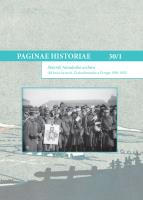Krizové jevy rakouské demokracie 1918–1922
The Crisis Phenomena of Austrian Democracy 1918–1922
Author(s): Miroslav ŠeptákSubject(s): History, Political history, Interwar Period (1920 - 1939)
Published by: Národní archiv
Keywords: political crisis; democracy; national identity
Summary/Abstract: The first Austrian democracy was built on shaky foundations. The crisis phenomena continuously undermined its further development. They included the estranged political culture that crucially influenced the character, quality, and orientation of the Austrian political system. Political parties criticised the parliamentary democracy as an ineffective system of rule and requested a transformation of the internal power structure in the corporative or socialist sense. The non-existence of the Austrian state and national identity caused the sentiment that an annexation of the Alpine republic to Germany was preferred to its independence. Moreover, a part of influential politicians and publicists supported the Anschluss, pointing out the necessity of joining the small Austrian internal market to a larger economic territory. The victorious powers, especially France and Italy, ignored these voices and wishes of the majority of Austrian citizens. Therefore, the relevant stipulations of the Treaty of Saint-Germain pushed the Anschluss away to the theoretical level. In 1922, Austria found itself on the brink of economic collapse. Federal Chancellor Ignaz Seipel successfully negotiated a loan under the patronage of the United Nations that was ratified by the Geneva Protocols. The international rescue contributed to the stabilisation of the Austrian economy and launched the consolidation of internal political situation. After four turbulent years, Austria set out towards greater stability.
Journal: Paginae Historiae
- Issue Year: 30/2022
- Issue No: 1
- Page Range: 421-433
- Page Count: 13
- Language: Czech

